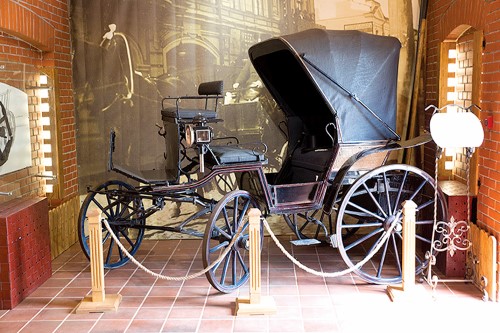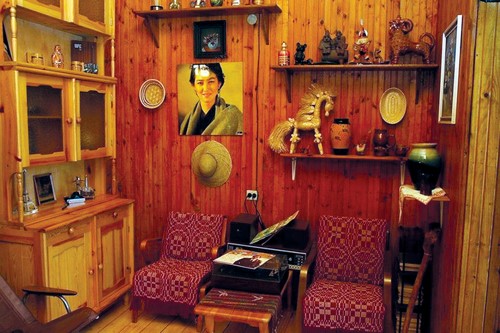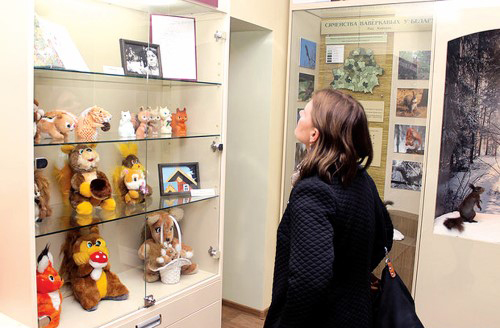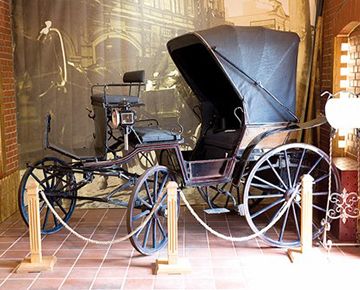
The ‘Carriage’ sculpture, near the Town Hall, has long been a symbol of Minsk but few realise that a Museum of Carriages is located nearby, within the grounds of the former Bernardine Monastery, at 8, Kirill and Mefodiy Street.
Guide Lidia Markovich tells us that, in the 19th century, stables for carriages were located there; the current building is in the style of that age. Sadly, no original exhibits remain from that time, requiring experts to have looked far and wide. It now houses light carriages, ‘drobnyaki’, phaetons, a 100-year-old sledge made by L.Y. Leibman, and carriages produced at the iron and mechanical plant run by N.Y. Yakobson.

No less interesting is the multimedia exhibition, featuring sound effects of the knocking of hoofs and neighing of horses. Video clip compilations of archival photographs show early 20th century Minsk, including the busy crossroads of today’s Nezavisimosti Avenue and Engels Street, which was destroyed in the first days of the war.
Olivaria Brewery also has its own museum, although you need to book onto an organised tour. Its exhibits are fascinating. Visitors gain true insight, being able to see machinery in operation and sample various grades of beer. Olivaria tour guide Anna Telesh tells us that even the building itself, on Kiselev Street, is worth seeing, being among the oldest in the city, at 125 years old. Its ownership has changed over time but beer has always been made there. Even if you aren’t a fan of the beverage, you’re sure to enjoy seeing ‘behind the scenes’.

Belarus boasts about 100 bakeries, but there is only one Museum of Bread, in the Ivanovo District’s Motol. Villagers have a special attitude to the ‘round loaf’, passing recipes and rituals from one generation to the next. They are even applying for UNESCO World Heritage status. Traditionally, round loaves are baked for celebratory events, such as weddings. The ‘Merry Loaf’ ceremony (called here ‘Gaspadar’) is such that only married women with a son and daughter may join in creating the loaf.

The museum features over 100 rare utensils used in bread making and, of course, visitors can try their hand at the ancient art: sifting flour, kneading dough, forming the loaf and so on. The museum has plans to create more interactive features but does already have a film devoted to ancient bread ceremonies, which is fascinating to watch.

In 1754, the town of Bolshaya Berestovitsa received its coat of arms: a squirrel on an oval shield. It also received its Magdeburg Right, from King August ІІІ. Since then, this small animal has been honoured in the region and, last autumn, it launched its Museum of Squirrels. Head curator Anastasia Veselukha-Volkova explains that the museum has about 600 ‘inmates’: most being small animals. A Chilean beauty — a live degu — greets visitors: just remember not to try and touch it or offer food. One cabinet displays the fur of various small animals: hares, foxes and raccoons. You can even stroke each sample. An interactive map shows the expansion of 27 species of squirrels worldwide.

The museum also boasts items of heraldry, stamps and coins on the theme. Coins from Norway and Andorra feature, as do some from the country of Quisqueya, which no longer exists.
Last summer, the museum-cottage of Vasily Bykov opened its doors, on the outskirts of Minsk, where the writer was inspired to write, draw and create, until his dying day. Surrounded by birches, the picturesque site became desolate following his passing, but was transferred to the state by his widow in 2012. Renovations have been necessary, but the original furniture and personal belongings remain, so that it appears just as it did in Bykov’s time. The Director of the State Museum of Belarusian Literary History, Lidia Makarevich, notes that his favourite sofa, desk and typewriter, with notebook, can be found in his study. His jacket hangs over the chair. Meanwhile, his studio is filled with boxed and tubed paints, and magazines.

During Bykov’s lifetime he rarely slept at his cottage, since it was not well heated and lacked necessary conveniences. For this reason, the museum only opens seasonally. Sadly, major repairs are currently necessary (to ensure the safety of exhibits and comfort of visitors) so the site isn’t open at present. However, as Ms. Makarevich confirms, Bykov’s atmosphere will be preserved, so that it may be enjoyed for many years to come.
By Alexander Pimenov











